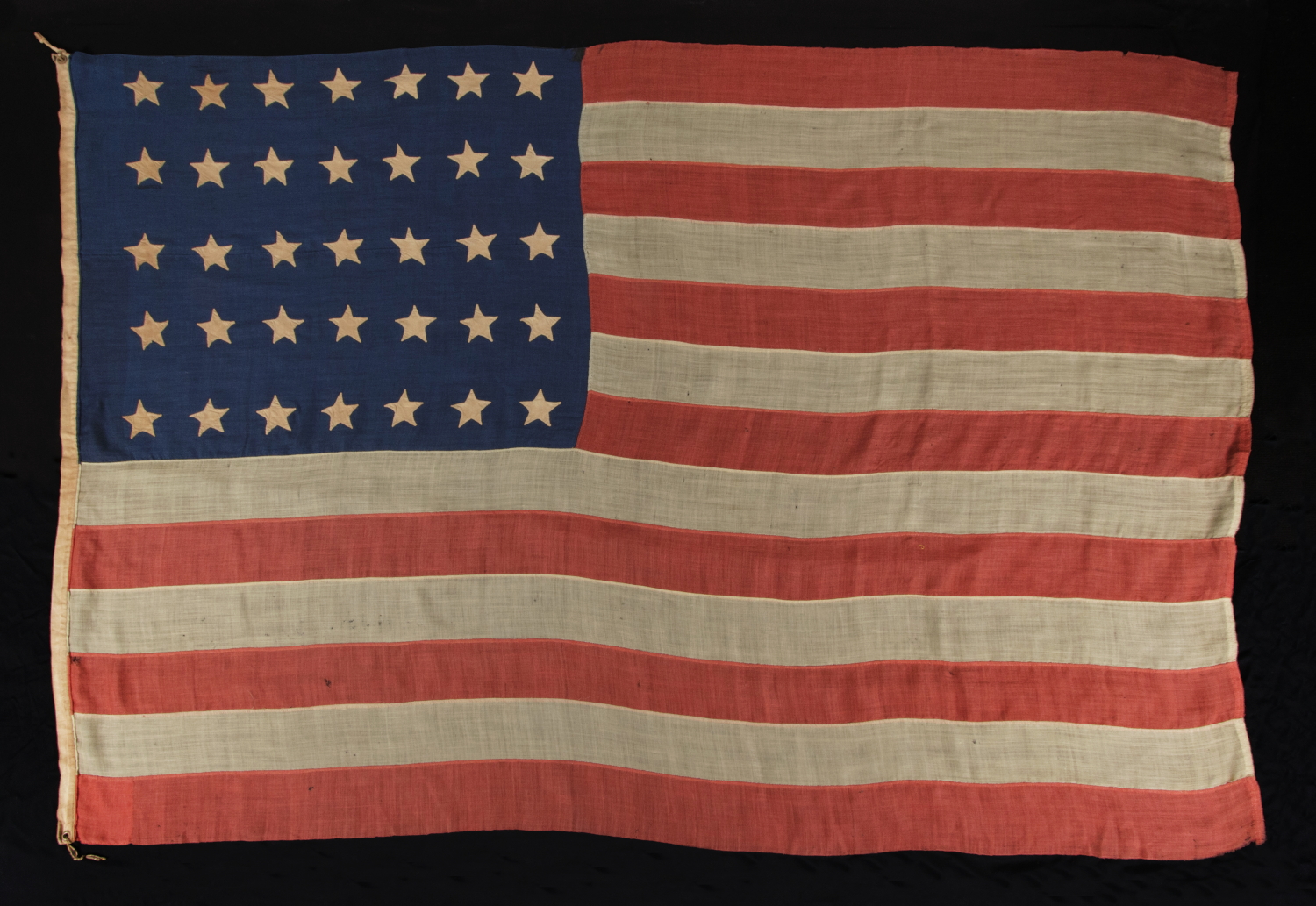
| |
35 HAND-SEWN, SINGLE-APPLIQUÉD STARS ON AN CIVIL WAR PERIOD FLAG WITH HAND-SEWN STRIPES, 1863-1865, WEST VIRGINIA STATEHOOD |
|
| Available: |
Sold |
| Frame Size (H x L): |
n/a |
| Flag Size (H x L): |
68.5" x 102.25" |
|
| Description....: |
|
35 HAND-SEWN, SINGLE-APPLIQUÉD STARS ON AN CIVIL WAR PERIOD FLAG WITH HAND-SEWN STRIPES, 1863-1865, WEST VIRGINIA STATEHOOD:
35 star American national flag of the Civil War period, in a large scale typical of the 19th century. West Virginia broke off from Virginia and was admitted into the Union as the 35th state on June 20th, 1863, a few days before the battle of Gettysburg. The 35th star was officially added on July 4th and the flag was used during the closing years of the war. Production would have generally ceased one year later, however, with the addition of Nevada as the 36th state.
The stars of the flag are made of cotton, hand-sewn, and single-appliquéd. This means that they were applied to one side of the canton, then the blue fabric was cut from behind each star, folded over, and under-hemmed, so that one star could be viewed on both sides. I always find single-appliquéd stars more interesting, not only because they are evidence of a more difficult level of seam-work and stitching, but even more so because they are usually more visually pleasing. Because two rows of hand-stitching are visible on single-appliquéd stars, the stitching is more apparent, which emphasizes its hand-sewing construction and is more endearing. This feature appeals to connoisseurs of early American textiles.
The stripes and canton of the flag are made of wool bunting that has been pieced and sewn by hand. Because perhaps 60% or more flags of this period have treadle-sewn stripes, hand-sewn stripes are a nice feature. The canton is pieced from two lengths of blue fabric because blue wool bunting was only available in a maximum width of eighteen inches. The rectangular patches at the top and bottom of the hoist end are original to the flag's construction. These are called gussets and were added for support at the points where the flag received the most stress when it was flown. There is a coarse linen binding along the hoist with two brass grommets, one each at the extreme top and bottom, through which lengths of hemp rope were threaded and tied. The binding was applied with a pump treadle machine and is the only part of the flag that is not hand-sewn.
Most flags with pieced-and-sewn construction made prior to the 1890's measured 8 feet long and larger. At 8 1/2 feet on the fly by just under 6 feet on the hoist, this may seem large by modern standards, but it was common and even could be considered on the small side for the Civil War period, at which time a garrison flag measured a whopping 35 to 45 feet.
Mounting: The flag has not yet been mounted. We are experts in the framing of antique flags. We employ professional staff with masters degrees in textile conservation and can attend to all of your mounting and framing needs.
Condition: The overall condition is remarkable for the period and wool construction. There is extremely minor mothing throughout. There is very minor fraying at the top and bottom of the fly end from obvious use, accompanied by a minor area of loss along the top where the canton meets the stripe field. There is minor staining along the hoist. Many of my clients prefer early flags to show their age and history of use. |
|
|
|
| Collector Level: |
Intermediate-Level Collectors and Special Gifts |
|
| Flag Type: |
Sewn flag |
|
| Star Count: |
35 |
|
| Earliest Date of Origin: |
1863 |
|
| Latest Date of Origin: |
1865 |
|
| State/Affiliation: |
West Virginia |
|
| War Association: |
1861-1865 Civil War |
|
| Price: |
SOLD |
|
| |
Views: 3377 |
|
|
|

